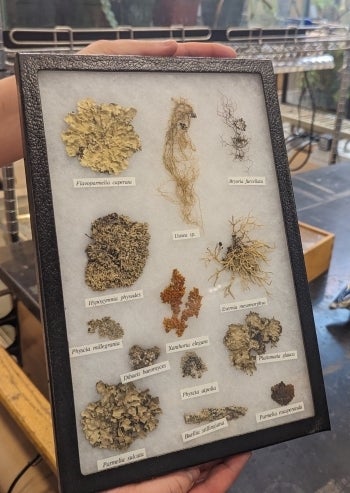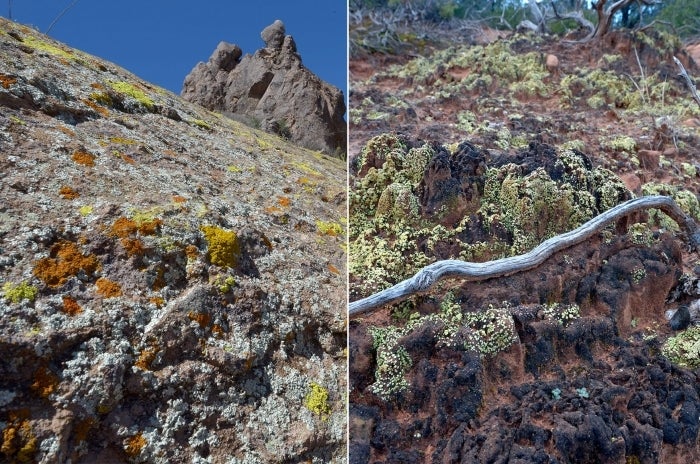For the love of lichens

Riley McInnis, recipient of the Benson Research Award. Courtesy photo
Lichens are unassuming; the low-growing life forms are easy to dismiss as mold or moss or a miscolored rock.
But there is more to them than meets the eye.
For starters, a lichen is not just one organism, but a complex of at least two organisms living in symbiosis –– a mutually dependent relationship. That, among many other qualities, is what makes Arizona State University graduate student Riley McInnis find lichen “fascinating”; so much so that theyRiley McInnis uses they/them pronouns. are dedicating their master’s capstone project to educating the public about these symbionts.
McInnis was just awarded the Bernard "Bill" Benson Research Award to support that project, which they hope will allow them to create a “lichen walk” at the Boyce Thompson Arboretum, complete with signs and interactive materials.
“I feel very validated,” McInnis says of winning the award, “like the work that I want to do is useful and that the world could use it. Thinking about how people will one day read those signs and learn something new about the world is really exciting for me.”
McInnis, who works full time as an academic support coordinator for the School of Life Sciences and hopes to have a career in science communication, is a lover of minute and overlooked things. They’ve made a point of taking more niche biology classes during their master’s studies, like a course on the grasses of Arizona and lichenology.
“I have a very firm belief that in order to understand the big stuff, you need to know the small stuff,” McInnis says with a smile. “Learning about lichens and their symbiosis is a really neat way to learn about ecology.”
Lichenologist and herbarium research specialist Frank Bungartz, of course, agrees. Lichens have great ecological importance, explains the ASU instructor. In the desert of the Southwest, for example, where lichens are so abundant that they turn entire cliff faces neon yellow, they are an important force that contributes to the weathering of rocks and boulders. In other instances, they may have the opposite effect: lichens can help form soil crusts that prevent erosion, which reduces the amount of dust storms.
Lichens only get more beautiful at a microscopic level. Bungartz dismisses other microorganisms like bacteria as “boring”; under a microscope, they only form relatively simple structures, shapes like spheres and filaments. Lichens, however, "have all this complexity that is kind of like artwork.”
This microscopic beauty inspired another student who works with Bungartz, William Martinez, to develop an immersive virtual reality experience that can allow humans to experience the minuscule world of lichens from the perspective of a mite.
“It looks like you’re walking through a total alien world,” the second-year graduate student says.
This is just one among various innovative approaches to educating people about lichens that Bungartz and his students have taken on. Another former graduate student, Guillermo Ortiz, just finished creating interactive 3D models of lichen-covered rocks for his master's degree, which will be used to both track lichen growth and help the public learn more about lichens. Bungartz has also given several talks on lichens and written articles aimed at the general public for outlets like the Arizona Native Plant Press.
McInnis, though, will be the first of ASU’s lichen enthusiasts to create an interactive educational experience. The Boyce Thompson Arboretum is the perfect site for such a project: besides being replete with lichen-covered rocks, it already has lots of educational signs and is well-attended by nature lovers. Still, there’s currently no educational material on lichens at the arboretum; resources about these unique but much overlooked organisms are generally rare.
By granting McInnis the Benson Research Award, the arboretum believes the public should learn to be "likin’ lichens," too.
More Science and technology

ASU-led space telescope is ready to fly
The Star Planet Activity Research CubeSat, or SPARCS, a small space telescope that will monitor the flares and sunspot activity of low-mass stars, has now passed its pre-shipment review by NASA.…

ASU at the heart of the state's revitalized microelectronics industry
A stronger local economy, more reliable technology, and a future where our computers and devices do the impossible: that’s the transformation ASU is driving through its microelectronics research…

Breakthrough copper alloy achieves unprecedented high-temperature performance
A team of researchers from Arizona State University, the U.S. Army Research Laboratory, Lehigh University and Louisiana State University has developed a groundbreaking high-temperature copper alloy…




